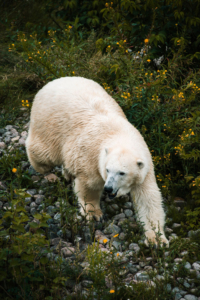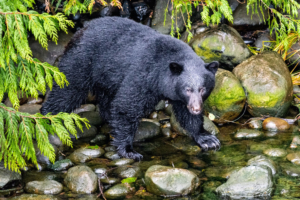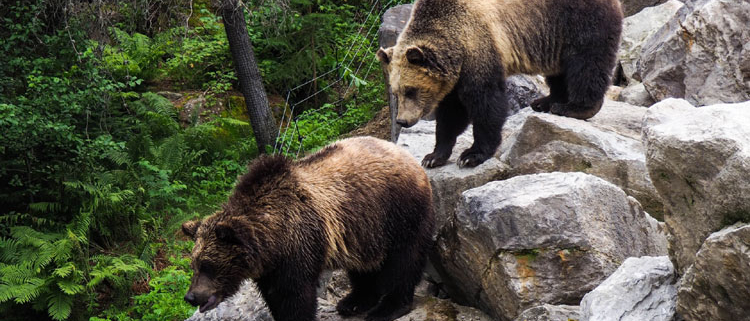Bear Safety 101: Navigating the Great Outdoors
Bear Encounter Etiquette:
Bear etiquette is a set of guidelines and behaviors designed to minimize human-bear conflicts, promote safety, and ensure the well-being of both people and bears. Whether you’re exploring bear country for recreational purposes or living in an area with bear populations, understanding and practicing bear etiquette is essential.
Kyla’s Rule #1: Expect the unexpected! Stay open minded, humble, and receptive to learning about bear safety. Just like us humans, every bears behavior and personality is different.
Parks Canada has up-to-date information as an added resource.

Make Noise:
- Bears can be startled if suddenly encountered, leading to defensive reactions. Make noise, especially in areas with dense vegetation or limited visibility, to alert bears to your presence.
- How? Clap your hands, talk loudly, or sing. Let bears know you’re there, giving them the opportunity to avoid you.
Travel in Groups:
- Bears are less likely to approach or feel threatened by larger groups of people.
- Travel in groups of two or more when hiking or camping in bear country. Some hiking trails post to travel in groups of 4 or more – “know before you go”.
Proper Food Storage:
- Minimize the likelihood of bears associating humans with food, which can lead to dangerous encounters.
- Secure Food and Garbage: Use bear-resistant containers, bear canisters, or hang food in bear bags away from the campsite.
In my Cochrane neighborhood every October we have bears looking for food in preparation for winter. The Town asks us to store our garbage bins indoors, and to consider not leaving Halloween pumpkins overnight. Ff we have fruit trees in our yards, we are asked to clean up fallen fruits to prevent attracting these magnificent animals.
Carry Bear Spray:
- Bear spray is a proven deterrent and can be effective in deterring aggressive bears.
- Holster Placement: Keep bear spray in an easily accessible holster on your belt or front of backpack.
- Maintain 100 Yards (91 Meters): Stay at least 100 yards away from bears, especially mothers with cubs.
Respect Bear Habitat:
- Reducing human impact on bear habitats helps maintain natural behaviors and minimizes conflicts.
- Stay on Trails: Stick to established trails to avoid disturbing sensitive habitats.
Avoid Mother Bears with Cubs:
- Reducing the likelihood of a defensive encounter with a protective mother, as mother bears are very protective of their young!
- If you see cubs, or a bear with cubs, give them a wide berth and alter your route.
Report Bear Sightings:
- Contribute to wildlife management efforts and helping authorities track bear movements.
- Contact Local Authorities: Report any bear sightings or encounters to local wildlife authorities. They need to know for population monitoring, behavioral studies, public safety, conservation efforts, and emergency response – just to name a few.
Understand Defensive vs. Aggressive Behavior:

- Assess the Situation: Determine the bear’s behavior. Calmly back away. Speak in a calm voice to identify yourself as a human.
- Avoid Direct Eye Contact: Bears may interpret direct eye contact as a threat or challenge. Do not stare directly at the bear; instead, glance periodically.
- Back Away Slowly: Back away slowly and avoid turning your back on the bear.

Recognize Signs of Bear Behavior:
Charging: Ears laid back, head lowered
-
- Stand your ground and be prepared to use your bear spray.
- A bear may bluff charge (or mock charge) and stop short. The bear is trying to get you to leave. Avoid turning and running.
Vocalizations: Huffing, growling or woofing sounds
-
- These vocalizations may indicate discomfort or aggression. Speak calmly to identify yourself as human and avoid aggressive movements.
Paw Swatting or Slapping: Swatting the ground or objects with the paws
-
- Retreat slowly without turning your back. Maintain looking toward the bear if possible.
Stiff and Direct Approach: A bear approaching directly with a stiff and deliberate gait may be displaying aggression.
-
- Stand tall, speak calmly, but firmly, and prepare to use bear spray if necessary.
Retreating or Moving Away:
-
- Defensive Sign: A bear actively avoiding confrontation by moving away is likely exhibiting defensive behavior.
- Allow the bear to retreat. Do not pursue or follow it.
Note that these behaviors are not always black and white, and the context of the situation matters. A bear’s behavior can change based on factors such as the presence of cubs, the bear’s age, environmental conditions, and the bear’s overall disposition. Always prioritize safety, avoid direct eye contact, and speak calmly in a non-threatening manner. If you have bear spray, be ready to use it if a bear approaches aggressively.

Using Bear Spray:
Carry Bear Spray:
- Always carry bear spray in an easily accessible holster on your belt or backpack. Ensure it is within reach in case of a sudden encounter.
Know Your Spray:
- Familiarize yourself with the operation of your bear spray. Watch videos and run mock practices to ensure you can deploy it quickly and effectively
Understand the Range:
- Bear spray typically has a range of 20 feet or more. Aim slightly downward to create a cloud that the bear must walk through.
Wind Consideration:
- Be mindful of wind direction. If possible, position yourself so the wind is at your back, carrying the spray toward the bear. Avoid spraying into a strong headwind.
- Consider bear spray to be like pepper spray. Avoid getting it in your own eyes, or you will also be blinded, causing retreat to be very difficult.
Effective Range:
- Only use bear spray when the bear is within a close and charging distance. Using it too early may result in the spray dissipating before it reaches the bear.
Aim for the Face:
- Aim for the face of the bear and spray in short bursts. The goal is to create a deterrent cloud, not to empty the entire canister at once.
Create a Barrier:
- If the bear continues to approach, create a barrier of spray between you and the bear by spraying in a sweeping motion, doing your best to try not to get into the ‘cloud’ yourself.
Back Away:
- Slowly back away from the area, keeping an eye on the bear. Do not turn your back on the bear until you are at a safe distance.
Here is a great video by Parks Canada on how to deploy bear spray:
When to Use Bear Spray:
During a Charge:
- Use bear spray when a bear is charging or exhibiting aggressive behavior. The goal is to deter the bear and give it an opportunity to retreat.
Surprise Encounters:
- If you unexpectedly encounter a bear at close range, especially in dense vegetation or around blind corners, be prepared to use bear spray.
Defensive Behavior:
- If a bear shows signs of defensive behavior (standing on hind legs, huffing, jaw-popping), it may perceive you as a threat. Be ready to use bear spray.
Remember, the primary goal is to avoid encounters by making noise, traveling in groups, and being aware of your surroundings. Bear spray is a tool of last resort and should be used responsibly and in accordance with guidelines provided by wildlife management agencies.
Conclusion:
Bears are truly magnificent creatures, embodying strength, resilience, and a majestic presence that commands respect. As we venture into their natural habitats, it’s essential to remember that we are guests in their homes. Bears play a vital role in maintaining the ecological balance of their ecosystems, and their behaviors are often rooted in survival instincts. While their sheer size and power may evoke awe, it’s crucial to recognize that bears generally mean no harm. They are intelligent beings with complex social structures and familial bonds.
Respecting their space and understanding their behaviors fosters a harmonious coexistence, allowing us to appreciate the beauty of these remarkable animals while ensuring our safety and theirs. With responsible behavior, awareness, and adherence to bear etiquette, we can share the wilderness with these magnificent creatures, appreciating the privilege of witnessing them in their natural habitats.



